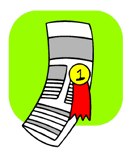Evaluating Newsletters
 Newspapers, newsletters, and other documents are just a few of the many tools that can make parents and other members of the community feel a part of the school. Newsletters are a great way to build positive relationships with parents. Photographs of children at work and play demonstrate for parents the supportive atmosphere of the classroom. Student produced artwork and articles show parents that their students are productive.
Newspapers, newsletters, and other documents are just a few of the many tools that can make parents and other members of the community feel a part of the school. Newsletters are a great way to build positive relationships with parents. Photographs of children at work and play demonstrate for parents the supportive atmosphere of the classroom. Student produced artwork and articles show parents that their students are productive.
Before jumping into the development of newsletters, you'll want to explore the possibilities. Whether you're interested in creating a teacher-produced or student-generated communication, you'll find lots of newsletters to review on the Internet.
Use the following resources on this page:
Newsletter Examples
Many newsletters are available online. Most have been saved as Adobe Reader files. Go to Adobe to download the Adobe Reader software for free.
- Teacher Tap: School Newsletters, Newspapers, and Magazines
- Adobe's Digital Kids - sample digital photos by students
- Examples:
- National Scholastic Press Winners
- Paly Voice from Palo Alto High School
General Education and Information Newsletters
- Rural Roots (page that links to all the PDF issues) - a newsletter for place-based education
- Educational Adventures Newsletter (PDF document) - from the Alaska Region of the National Park Service
- Cedar Rapids Home School Assistance Newsletter
- Children's Literature
- National Geographic
Newsletter Evaluation Criteria
Use the following questions as you evaluate newsletters.
Overall
- Is the newsletter purpose and sponsorship immediately clear?
- Is the newsletter appealing and inviting?
- As the mission, goals, and objectives of the newsletter clear?
- Does this newsletter offer resources not available elsewhere?
Audience
- Who is the intended audience? Does the content match this audience?
- What is the purpose of the newsletter? Does it meet this goal?
- Is the "look and feel" of the newsletter appropriate for the audience and purpose?
Format
- Is the logo or title area attractive and eye-catching?
- Does the standard format provide a "brand" that readers recognize?
- Is information provided about the authors?
- Is content information provided?
- Is there a regular arrangement of columns and articles for quick scanning?
Content
- Do the headlines draw attention and reflect the content of the articles?
- Are the headline active (using verbs) to attract readers?
- Does the lead article convey excitement about news?
- Is the content accurate and high quality?
- Is the content objective, opinions identified, and perspectives balanced?
- Are authentic resources used (i.e., reviewed materials, established sources, primary materials)?
- Is current, timely, and interesting information provided?
- Is the content presented in an efficient and effective manner?
- Is the breadth of the content effective (i.e., goes beyond basic facts and data)?
- Does the depth of content match the varied audience needs?
- Does the newsletter provide resources that go beyond the ordinary (i.e., unique, local, special)?
- Is the content free from spelling, grammatical, and other typographical errors?
- Is the writing clear and appropriate for the developmental and reading level of the audience?
- Does the content convey excitement, passion, and commitment to learning?
- Does the newsletter contain a mix of content formats (i.e., text, graphics, photographs, charts, drawings) to address specific needs?
- Is the content logically organized?
- Does it fully report information?
- Is credit given to text and visual sources?
Layout
- Does the newsletter have an effective front page (i.e., attractive, logos, slogan, colors/shading)?
- Does the newsletter have a standard, consistent "look and feel" throughout (i.e., standard template or standard sections)?
- Is there a standard style used for fonts, typestyles, etc.?
- Does the newsletter make appropriate use of fonts (i.e, font type, style, size, color, ease of reading)?
- Is the page layout effective and visually appealing?
- Does the graphic design reflect the purpose of the site (i.e., serious, whimsical, visually interesting)?
- Is the design attractive for the intended audience?
- Is there a consistent theme or layout throughout the newsletter?
- Does the graphic design add to (not distract from) the site?
- Are the pages consistent, well-organized and free from clutter?
- Does the layout demonstrate the relative importance of articles through type size, lines, and other elements?
- Does the format look like a newsletter rather than a report?
- Does the layout contain adequate white-space?
- If columns are used, are they effective in organizing information?
- Is the organization consistent from one newsletter to the next?
- Are colors, lines, and other visual elements used effectively?
- Do photographs and other graphics elements attract rather than distract from the appearance?
Product
- Is the text clear and easy to read?
- Are the images clear and easy to see?
- Is there enough contrast better paper color and printing for easy reading?